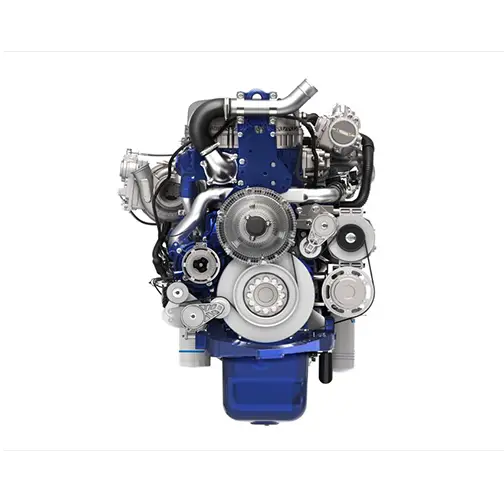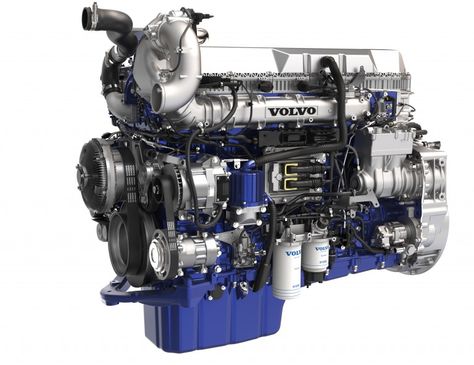The Volvo D13 is a 12.8-liter diesel engine with 405-500 hp and 1,450-1,850 lb-ft of torque. It’s efficient, durable, and equipped with advanced technology like a Variable Geometry Turbocharger and SCR to reduce emissions. Ideal for long-haul and vocational trucks.
The Volvo D13 engine is one of the most popular and versatile engines used in heavy-duty trucks today. Designed with efficiency, reliability, and performance in mind, the D13 powers a wide range of vehicles from long-haul trucks to vocational applications. The engine’s advanced technology, combined with Volvo’s commitment to sustainability and low emissions, has made it a go-to choice for fleets and owner-operators alike.
In this post, we’ll delve into the key specifications, technological advancements, and benefits of the Volvo D13 engine.

Contents
Overview of the Volvo D13 Engine
The Volvo D13 is a 12.8-liter engine that belongs to Volvo’s family of heavy-duty engines. It’s widely known for its balance between power, fuel efficiency, and environmental performance. The engine is often used in Volvo’s VNL, VNR, and VNX series trucks.
The D13 engine comes in multiple configurations, allowing fleet managers to choose the power output that best suits their specific needs, whether for regional hauling, long-distance driving, or vocational applications. Its architecture incorporates several advanced technologies to enhance performance while reducing emissions, making it compliant with stringent environmental standards.
Key Specifications of the Volvo D13 Engine
Here are the core specifications of the Volvo D13 engine, giving you a detailed look into its capabilities:
| Specification | Details |
|---|---|
| Engine Type | Inline 6-cylinder, turbocharged |
| Displacement | 12.8 liters |
| Horsepower | 405 to 500 hp |
| Torque | 1,450 to 1,850 lb-ft |
| Bore and Stroke | 131 mm x 158 mm |
| Compression Ratio | 16:1 |
| Weight | 2,540 lbs (dry) |
| Fuel Type | Diesel |
| Emission Standards | EPA 2010 and GHG 2014 Compliant |
| Engine Brake | Volvo Engine Brake (VEB+) |
| Oil Capacity | 42 quarts |
| Cooling System | 40.5 quarts |
The D13 engine provides a wide range of horsepower and torque configurations, making it versatile enough for different truck applications. The engine is also optimized for fuel economy without sacrificing power, which is a significant benefit for fleet operators.
Performance and Efficiency
The Volvo D13 is highly regarded for its balance between power and fuel efficiency. Volvo has integrated several performance-enhancing technologies into the D13 engine, ensuring that it delivers power while maintaining cost efficiency over the long term. Some key features that boost the engine’s performance and efficiency include:
Variable Geometry Turbocharger (VGT)
The VGT allows for optimal airflow management across a wide range of engine speeds. This not only improves power output but also reduces turbo lag, providing smoother and more responsive driving. The VGT also helps improve fuel efficiency by optimizing combustion.
Common Rail Fuel Injection System
The D13’s common rail fuel injection system provides precise fuel delivery, improving both efficiency and power. The system operates at high pressure, which allows for better atomization of the diesel fuel, leading to cleaner and more complete combustion. This results in reduced fuel consumption and lower emissions.
i-Shift Transmission Compatibility
The D13 engine is often paired with Volvo’s highly regarded I-Shift automated manual transmission. This combination improves fuel efficiency, driver comfort, and overall vehicle performance. The I-Shift transmission features intelligent shift logic that adapts to the load, grade, and driving conditions, ensuring optimal gear selection and fuel usage.
Engine Brake (VEB+)
The D13 engine comes with the Volvo Engine Brake (VEB+), which is an integrated engine braking system designed to improve vehicle control while minimizing brake wear. This system is particularly useful for downhill driving and provides better stopping power, increasing both safety and efficiency.
Environmental Performance
Volvo has always been at the forefront of environmental sustainability, and the D13 engine is no exception. The D13 complies with stringent emission standards, including the EPA 2010 and GHG 2014 standards, thanks to the inclusion of advanced aftertreatment systems.
Selective Catalytic Reduction (SCR)
The SCR system uses diesel exhaust fluid (DEF) to reduce nitrogen oxides (NOx) emissions, converting them into nitrogen and water vapor, which are harmless. This system has significantly reduced the environmental impact of heavy-duty trucking and has helped fleet owners meet regulatory requirements.
Diesel Particulate Filter (DPF)
The D13 also features a Diesel Particulate Filter (DPF), which captures soot and other particulate matter from the exhaust gases. The DPF ensures that the engine operates cleanly and complies with emissions regulations while maintaining high performance.
Enhanced Combustion Technology
By optimizing fuel injection and air management, the D13’s combustion process is more efficient, reducing CO2 emissions. This is part of Volvo’s commitment to reducing the carbon footprint of its vehicles and helping fleet operators lower their overall environmental impact.
Durability and Maintenance
One of the hallmarks of the Volvo D13 engine is its long-lasting durability. Built with high-quality materials and a focus on reducing wear and tear, the D13 is known for its reliability over the long haul. Volvo’s engines undergo rigorous testing to ensure that they can handle the harsh conditions of heavy-duty trucking.
Extended Service Intervals
Volvo has designed the D13 engine with extended service intervals, reducing downtime for maintenance and repairs. Depending on the application and duty cycle, oil change intervals can extend up to 70,000 miles, which significantly lowers maintenance costs.
Robust Engine Components
From the crankshaft to the cylinder block, the D13 engine uses heavy-duty materials that can withstand the stress of daily operations. The engine is built to resist high temperatures, pressure, and wear, ensuring a long operational life.
Easy Maintenance Access
The D13 engine is designed with maintenance in mind, providing easy access to critical components. The location of the oil filter, fuel filter, and other serviceable parts reduces the time mechanics spend on routine maintenance, further minimizing downtime.

Applications of the Volvo D13 Engine
The versatility of the D13 engine allows it to be used in various applications, including:
- Long-Haul Trucks: Its excellent fuel efficiency and power make it a perfect fit for long-distance freight transportation.
- Regional Hauling: With multiple power options, the D13 is ideal for regional deliveries, where both performance and efficiency are crucial.
- Vocational Trucks: The D13 is also suitable for vocational applications, such as construction, refuse collection, and other heavy-duty uses, thanks to its robust design and torque output.
Advantages of the Volvo D13 Engine
The D13 engine offers several advantages for operators and fleet managers, including:
- Fuel Efficiency: With advanced fuel management systems, the D13 reduces fuel consumption, lowering operational costs.
- Durability: Built to last, the D13 requires less frequent maintenance and has a long service life.
- Emissions Compliance: The D13 meets stringent emissions standards, helping fleets stay compliant with regulations.
- Versatility: With multiple configurations, the D13 can power a wide range of trucks for various applications.
- Driver Comfort: Paired with the I-Shift transmission, the D13 provides smoother driving, reducing fatigue for long-haul drivers.
Frequently Asked Questions
Here are some FAQs about volvo d13 engine specs –
1. What kind of fuel economy can I expect from the Volvo D13 engine?
Fuel economy depends on the configuration and application, but the D13 is known for its efficiency. In general, long-haul trucks equipped with the D13 can see fuel savings of 3-5% compared to older engine models.
2. How often does the Volvo D13 engine require maintenance?
The D13 engine has extended service intervals, with oil changes required every 50,000 to 70,000 miles, depending on usage. This reduces downtime and maintenance costs.
3. Is the Volvo D13 engine suitable for vocational applications?
Yes, the Volvo D13 engine is versatile enough for both long-haul and vocational applications. It offers different horsepower and torque options, making it adaptable for various uses such as construction, refuse collection, and regional hauling.
4. What transmission is compatible with the Volvo D13 engine?
The D13 engine is often paired with Volvo’s I-Shift automated manual transmission, which optimizes gear shifting for improved fuel efficiency and driver comfort.
5. How does the Volvo D13 engine meet emissions standards?
The D13 engine uses Selective Catalytic Reduction (SCR) and a Diesel Particulate Filter (DPF) to reduce emissions, making it compliant with EPA 2010 and GHG 2014 standards.
Conclusion
The Volvo D13 engine stands out as one of the best choices for heavy-duty trucking applications, offering a strong combination of performance, efficiency, and environmental friendliness. Its advanced technologies, robust construction, and versatility make it a popular choice for fleet operators looking to reduce costs and emissions while maintaining high levels of performance.
Whether you’re running a long-haul operation or managing a fleet of vocational trucks, the Volvo D13 engine delivers reliable and consistent power, ensuring that your trucks stay on the road longer with fewer disruptions.